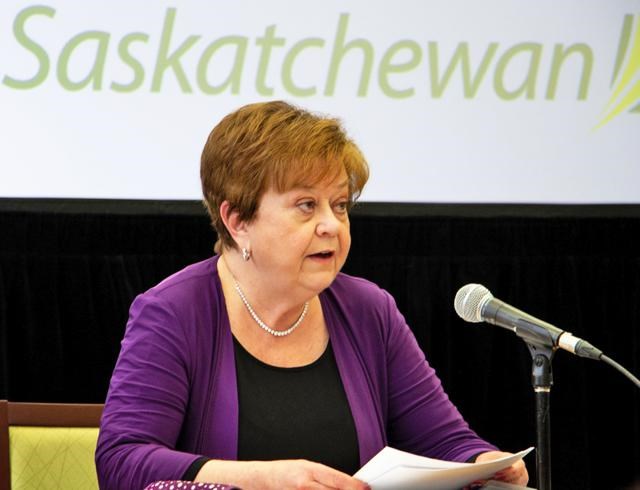The province released their full budget on Monday which showed a $1.9 billion addition to the debt total that can be attributed to the COVID-19 pandemic.
According to the provincial budget, public debt will rise by $3 billion in 2020-21 including the $1.9 billion attributable to COVID-19.
In addition, a deficit of $319 million is now expected for 2019-20 as a result of “economic deterioration” over the final quarter of the year.
Additionally, oil investment and production in Saskatchewan are expected to decline by 37.1 per cent and 13.8 per cent respectively. Some projections say the price of oil will average $37 dollars a barrel in 2020 and rise to $48 a barrel in 2021.
The report says Saskatchewan is “seemingly well-positioned” to face the challenges going forward. According to the province, agriculture exports were up 20.1 per cent year-over-year.
“Although total goods exported in April still fell by 8.2 per cent, other provinces experienced much larger declines,” the report said. Real GDP is projected to decline by 6.3 per cent this year while nominal GDP is anticipated to fall by 12.8 per cent.
The province also said average employment in Saskatchewan in 2020 is forecast to decline by 15,800. The province said the economic growth outlook for 2021 is “positive.”
“Oil prices are expected to rebound as well next year as global growth picks up. Saskatchewan real GDP is forecast to grow by 4.6 per cent in 2021 while nominal GDP is forecast to rise by 7.2 per cent.”
The provincial budget said despite the ongoing success of the Re-Open Saskatchewan Plan, considerable uncertainty with respect to the pace and strength of the economic recovery exists, both in Saskatchewan and around the world.
“The fiscal outlook assumes that global measures to limit the spread of COVID-19 will be successful and that the economic impact of the recent pandemic will be relatively short. Any deviation from this assumed path of economic recovery has the potential to alter the 2020-21 revenue outlook.”
Finance Minister Donna Harpauer said the province entered the crisis in a strong financial position.
“Other provinces are expecting deficits that are comparably higher than ours. Saskatchewan was on track for a surplus in 2019-20 and 2020-21 prior to the COVID-19 pandemic and oil price collapse,” said Harpauer.
“The 2020-21 deficit is not a structural deficit. It is a pandemic deficit,” she added.
Revenue is forecast to be $13.6 billion, down $1.2 billion, or about eight per cent from last year, a result of the shuttering of domestic and global economies to contain the spread of COVID-19, combined with the oil price collapse.
The 2020-21 budget includes $16.1 billion in spending, an increase of $1.1 billion, or about seven per cent compared to last year. This includes record spending on health care, which is vital during the COVID-19 pandemic. The budget also invests strongly into many needed programs and services.
To help stimulate Saskatchewan’s economic recovery and create jobs, the province’s capital plan in the 2020-21 Budget includes a $3.1 billion investment to build hospitals, schools, highways, municipal and Crown corporation infrastructure.
Over the next two years the province will invest $7.5 billion as part of its capital plan, which includes $2.0 billion announced in May to help further stimulate the economy and create jobs.
“These are projects that will result in much needed economic activity and jobs,” Harpauer said. “Saskatchewan is fortunate to be in a strong financial position to make these kinds of important capital investments in every part of our province.”
The 2020-21 budget includes more than $1.0 billion in support to fight the pandemic, for individuals, for businesses and for initiatives to help the economy recover.
The 2020-21 Budget provides a record $278 million in Municipal Revenue Sharing, which is up nearly $27 million from last year, or 11 per cent. In total, this budget invests more than $571 million in direct provincial support to Saskatchewan’s municipalities, an increase of $137 million, or 31.4 per cent, over last year. This includes revenue sharing, and the $150 million Municipal Economic Enhancement Program, additional infrastructure funding, and a number of grants and initiatives from various government ministries.
The government will invest $3.1 billion into infrastructure in 2020-21. It’s the first year of an enhanced two-year $7.5 billion capital plan to invest in schools, hospitals, highways, Crown utility projects, municipal infrastructure and other needed projects to stimulate our economy, create jobs and build a strong Saskatchewan. The plan received a $2.0 billion injection in May to further help the economy recover over the next two years.
In total, the 2020-21 Budget now includes more than $900 million in new supports to fight the pandemic. This includes an additional $502 million of new expenses forecast after March 18, for COVID-19 related support programs and economic stimulus.
The new expenses include:
• $171 million of new capital funding for third parties, including $150 million for the Municipal Economic Enhancement Program for shovel-ready infrastructure projects;
• $150 million for the Accelerated Site Closure Program for the reclamation of inactive oil and gas wells and facilities;
• $56 million for the Temporary Wage Supplement supporting those workers who are helping some of our most vulnerable in our province through the pandemic;
• $50 million for the Saskatchewan Small Business Emergency Payment providing support to small and medium-sized businesses that have had to temporarily close or significantly curtail operations because of the COVID-19 pandemic.




